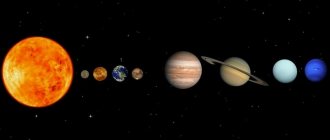How many galaxies are there in the Universe? The answer to this question is very difficult. Many astronomers in the past tried to understand how many galaxies there are in the Universe. Counting them seems like an impossible task. When the count is in the billions, it takes a while to add up. Another challenge is the limited number of tools we have. To get the best image, the telescope must have a large aperture (the diameter of the primary mirror or lens) and be positioned above the atmosphere to avoid distortion from Earth's air.
Hubble field
You may be interested in:What is morocco: what is it made from, what is it used for
Perhaps the most resonant example of the above-mentioned fact is the Hubble Extreme Deep Field, an image obtained by combining photographs taken over a decade from the Hubble telescope. According to NASA, the telescope observed a small area of the sky for 50 days. If you hold your thumb at arm's length to cover the Moon, the deep field area will be the size of the head of a pin.
By collecting faint light over many hours of observation, the Hubble telescope has discovered thousands of galaxies, both near and far away, making its images the most complete picture of the universe yet. So even if there are thousands of galaxies in this small spot in the sky, imagine how many more can be found elsewhere in the universe.
You may be interested in: Alcohol Denat - what is it: formula, method of preparation, application, effect on the body
Coma A (NGC 4874)
NGC 4874, also known as Coma A, was discovered in 1785 by British astronomer Frederick William Herschel I. It is 350 million ly away. years years from Earth.
It is a smooth, spherical galaxy surrounded by a halo of stars, about a million light years across. At its center is a supermassive black hole. The high-energy plasma jet extends to a distance of 1700 light. years from its center.
Expert assessments
Although estimates vary among experts, answers to questions like “How many galaxies are there in the Universe?” can be expressed in astronomical figures: from 100 to 200 billion. When the James Webb Space Telescope launches in 2020, NASA is expected to reveal even more information about the early galaxies in the universe.
Technology truly works wonders. As far as modern astronomers know, the Hubble Telescope is the best tool for counting and estimating how many galaxies are known in the Universe. The telescope, launched in 1990, initially had distortion on the main mirror, which was corrected during a shuttle visit to it in 1993. Hubble also underwent several upgrades and service visits until its final mission in May 2009. Is the Universe infinite, how many galaxies, how many planets are there? Apparently we have yet to find out in the future.
Approximate quantity
We know exactly as much about our Universe as telescopes and probes allow us to know. Every year, more advanced equipment finds new and even more mysterious horizons. In view of this, both the age of the found objects and their sizes are adjusted. So, how many worlds still exist in space? An exact or approximate answer can only be obtained by modeling the Universe. And this is practically impossible, due to the fact that irreversible changes occur in it every second.
https://kosmogid.ru/%D0%BA%D0%B0%D0%BA-%D1%83%D1%87%D0%B0%D1%81%D1%82%D0%B2%D0%BE% D0%B2%D0%B0%D1%82%D1%8C-%D0%B2-%D1%82%D0%B5%D0%BD%D0%B4%D0%B5%D1%80%D0%B0% D1%85-%D0%BD%D0%B0-%D0%B3%D0%BE%D1%81%D0%B7%D0%B0%D0%BA%D1%83/
Source
Big Dipper
You may be interested in: Olmec culture: historical facts, everyday life, features
In 1995, astronomers pointed a telescope at what appeared to be an empty area of the Big Dipper and collected ten days of observations. As a result, about 3,000 faint galaxies were discovered in one frame, which became dim, like 30th magnitude. For comparison: Polaris is approximately second magnitude. This component of the image was called the Hubble deep field and was the most distant ever seen in the Universe.
When the above-mentioned American telescope was thoroughly modernized, astronomers repeated the experiment twice. In 2003 and 2004, scientists discovered about 10,000 galaxies in a small location in the constellation Fornax.
In 2012, again with upgraded instruments, scientists used the telescope to look at part of the ultra-deep field. Even in this narrower field of view, astronomers were able to detect about 5,500 galaxies. The researchers dubbed this "extreme deep field."
Hercules A
The Hercules A Galaxy is a bright source of radio waves located in close proximity to the constellation Hercules. According to modern research, this galaxy ranks second in size among all galaxies known today. Studies show that Hercules A is more than 1000 times more massive than the entire Milky Way. At its center lies a gigantic black hole, the mass of which is four billion times greater than the Sun and almost 1000 times the mass of the black hole at the center of the Milky Way. Hercules A is about 1,500,000 light years across.
Cosmological principle and age of the Universe
One example of a cosmological principle in the study of the Universe is the cosmic microwave background, radiation that is a remnant of the early stages of the Universe after the Big Bang.
Measurements of the expansion of the Universe through observations of galaxies moving away from us indicate that it is about 13.82 billion years old. However, as the Universe gets older and larger, galaxies will move further and further away from Earth. This will make them more difficult to see.
The universe is expanding faster than the speed of light (which does not violate Einstein's speed limit, because the expansion is due to the universe itself, not to objects traveling through it). In addition, the Universe is accelerating in its expansion.
This is where the concept of the “observable universe”—the universe that we can see—comes into play. According to many experts, in 1-2 trillion years this will mean that there will be galaxies that are beyond the spaces that we can see from Earth.
solar system
The solar system is 4.5 billion years old and is located in the shape of a disk. The heaviest element of the system is its center - the Sun, which accounts for almost all the mass, which determines the strong gravitational attraction. The eight planets orbiting it make up just 0.14% of the system's total mass. Earth belongs to the four small terrestrial planets, along with Mars, Venus and Mercury. The remaining planets are called gas giants because they consist mostly of gases.
The future of the Milky Way
Galaxies also change over time. The Milky Way is on a collision course with the nearby Andromeda Galaxy, and the two will merge in about four billion years. Later, other galaxies in our local group will eventually merge. Astronomers believe that the inhabitants of these future galaxies will observe a darker Universe.
When the first civilizations appeared, they had no evidence of the existence of a Universe with a hundred billion galaxies. Therefore, our descendants will not see the expansion of the Universe. They probably won't even be able to understand that the Big Bang happened.
If we, ordinary people, want to know how many galaxies and planets there are in the Universe, then astronomers are more interested in how the cosmos itself was formed. According to NASA, galaxies provide insight into how matter is organized in the universe—at least on a large scale. Scientists are also interested in particle types and quantum mechanics on the small side of the observed spectra.
New inventions
However, visible galaxies are just the tip of the iceberg. For every galactic group captured by astronomers, there are 9 more faint and invisible systems. Of course, recent developments indicate that in a short period of time, earthlings will be able to capture previously invisible bodies.
Thus, in 2022, a powerful James Webb telescope appeared, the area of which reaches 25 square meters. If we compare the unit with the famous Hubble, we can note that its figure is only 4.5 square meters. m. Therefore, those incomprehensible invisible spots that are inaccessible to the eye of astronomers will at one time become identifiable objects, and we will be able to obtain as much information as possible about them.
If galactic groups are located almost everywhere, a logical and fair question arises: why cannot they be detected with the naked eye? The point is a paradox, the description of which happened in 1700. Its essence lies in the fact that no matter where a person looks, he will still end up looking at a star. After all, it is bright, unlike the rest of the space, which is dark. A similar situation is observed with galaxies.
Early galaxies
By studying some of the earliest galaxies and comparing them to today's, we can understand their growth and development. The cutting-edge telescope, called Webb, will allow scientists to collect data on the types of stars that existed in the earliest galaxies. Follow-up observations using spectroscopy of hundreds or thousands of galaxies will help researchers understand how elements heavier than hydrogen were formed and accumulated as star clusters formed over the centuries. These studies will also reveal the details of their fusion and shed light on many other processes.
Origin of the term
The word "galaxy" is translated as "milk ring". This is how ancient scientists saw the phenomenon in the form of a glow in the night sky. Looking at the sky with the naked eye, they assumed that nebulae were glowing on it. When it was suggested that these were huge clusters of stars, they began to be called star islands or island universes. After finding out the fact that spiral-shaped celestial objects are similar to our galactic system, they all began to be called galaxies, and other terms are used extremely rarely.
Large Magellanic Cloud
The galaxy is located 163,000 light years from Earth. Belongs to the SBm type of galaxy. The diameter is about ten times smaller than the diameter of the Milky Way and is 190,000 light years. The Large Magellanic Cloud contains over 30 billion stars, while the Milky Way has about 1.5 billion. Named after the navigator Ferdinand Magellan, who observed this star cluster during his voyage in 1519.
Andromeda
The galaxy got its name in honor of the mythical princess. The Andromeda nebula is the closest large galaxy to Earth, with a diameter of about 220,000 light years. The spiral galaxy has a mass that, according to various estimates, exceeds the mass of the Milky Way by 1.7-2 times. The Andromeda Nebula is 2.2 million light years away from Earth.
UGC 2885
According to official scientific data, the galaxy ranks 6th in the list of the largest clusters of stars known to date and holds the record among spiral galaxies. UGC 2885 is approximately 310 million light years away. According to research conducted in May of this year, the diameter of this spiral galaxy is approximately 832,000 light years. This is more than eight times the diameter of the Milky Way. It has the largest arms observed in Space to this day.
Condor Galaxy (NGC 6872)
The Condor Galaxy, also known as NGC 6872, is a giant spiral banded galaxy classified as an SB galaxy. Located in the constellation Pavo. The galaxy is 212 million light years away from Earth. NGC 6872 has two elongated arms that are 552,000 light years apart. It was discovered on June 27, 1835 by British astronomer John Herschel.











